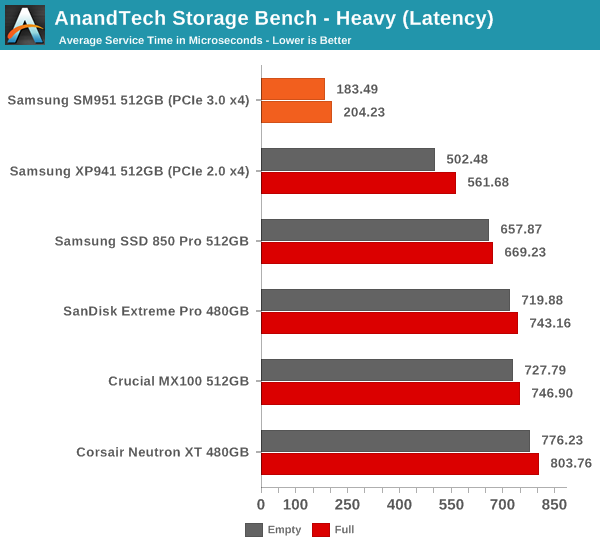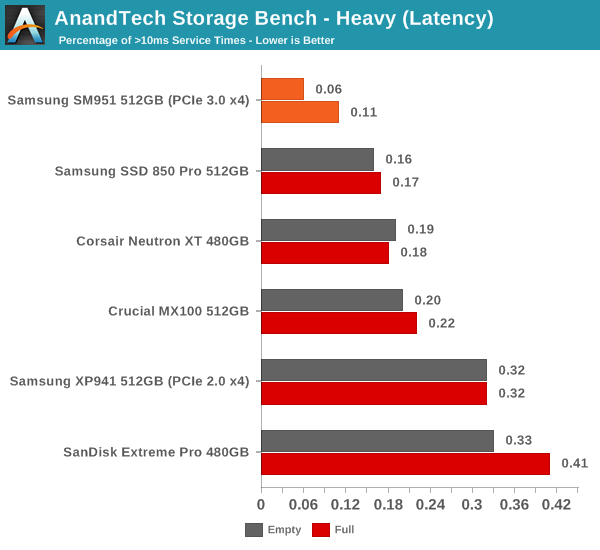Samsung SM951 (512GB) PCIe SSD Review
by Kristian Vättö on February 24, 2015 8:00 AM ESTAnandTech Storage Bench - Heavy
While The Destroyer focuses on sustained and worst-case performance by hammering the drive with nearly 1TB worth of writes, the Heavy trace provides a more typical enthusiast and power user workload. By writing less to the drive, the Heavy trace doesn't drive the SSD into steady-state and thus the trace gives us a good idea of peak performance combined with some basic garbage collection routines.
| AnandTech Storage Bench - Heavy | ||||||||||||
| Workload | Description | Applications Used | ||||||||||
| Photo Editing | Import images, edit, export | Adobe Photoshop | ||||||||||
| Gaming | Pllay games, load levels | Starcraft II, World of Warcraft | ||||||||||
| Content Creation | HTML editing | Dreamweaver | ||||||||||
| General Productivity | Browse the web, manage local email, document creation, application install, virus/malware scan | Chrome, IE10, Outlook, Windows 8, AxCrypt, uTorrent, AdAware | ||||||||||
| Application Development | Compile Chromium | Visual Studio 2008 | ||||||||||
The Heavy trace drops virtualization from the equation and goes a bit lighter on photo editing and gaming, making it more relevant to the majority of end-users.
| AnandTech Storage Bench - Heavy - Specs | ||||||||||||
| Reads | 2.17 million | |||||||||||
| Writes | 1.78 million | |||||||||||
| Total IO Operations | 3.99 million | |||||||||||
| Total GB Read | 48.63 GB | |||||||||||
| Total GB Written | 106.32 GB | |||||||||||
| Average Queue Depth | ~4.6 | |||||||||||
| Focus | Peak IO, basic GC routines | |||||||||||
The Heavy trace is actually more write-centric than The Destroyer is. A part of that is explained by the lack of virtualization because operating systems tend to be read-intensive, be that a local or virtual system. The total number of IOs is less than 10% of The Destroyer's IOs, so the Heavy trace is much easier for the drive and doesn't even overwrite the drive once.
| AnandTech Storage Bench - Heavy - IO Breakdown | |||||||||||
| IO Size | <4KB | 4KB | 8KB | 16KB | 32KB | 64KB | 128KB | ||||
| % of Total | 7.8% | 29.2% | 3.5% | 10.3% | 10.8% | 4.1% | 21.7% | ||||
The Heavy trace has more focus on 16KB and 32KB IO sizes, but more than half of the IOs are still either 4KB or 128KB. About 43% of the IOs are sequential with the rest being slightly more full random than pseudo-random.
| AnandTech Storage Bench - Heavy - QD Breakdown | ||||||||||||
| Queue Depth | 1 | 2 | 3 | 4-5 | 6-10 | 11-20 | 21-32 | >32 | ||||
| % of Total | 63.5% | 10.4% | 5.1% | 5.0% | 6.4% | 6.0% | 3.2% | 0.3% | ||||
In terms of queue depths the Heavy trace is even more focused on very low queue depths with three fourths happening at queue depth of one or two.
I'm reporting the same performance metrics as in The Destroyer benchmark, but I'm running the drive in both empty and full states. Some manufacturers tend to focus intensively on peak performance on an empty drive, but in reality the drive will always contain some data. Testing the drive in full state gives us valuable information whether the drive loses performance once it's filled with data.

The SM951 performs even strongly in our Heavy trace and presents nearly 100% improvement in data rate over the XP941. In full state the SM951 loses a bit of its performance, but that's normal and the drop isn't any bigger than in other drives. Despite the lack of NVMe, it's starting to be clear that the SM951 is significantly faster than its predecessor and any SATA 6Gbps SSD.

The average latency is also cut in less than half, which is actually a more substantial improvement than going from a SATA 6Gbps drive to the XP941.

The share of high latency IOs is also the lowest with only 0.06% of the IOs having a higher than 10ms service time.










128 Comments
View All Comments
Laststop311 - Tuesday, February 24, 2015 - link
Also forgot to add really need the 1TB size because 25% OP is important to keep the drive fast 100% of the time.theduckofdeath - Tuesday, February 24, 2015 - link
Are you using your PC as the google.com web portal? :)Isn't 25% a bit excessive for a PC? I have 10% now and I can't really notice any difference from my previous install when I had around 15%....
philipma1957 - Saturday, February 28, 2015 - link
I agree with you as always ssd's are too small. I would love to get a 2tb ssd or even a 1.5tb ssdin pcie or 2.5 inch form factors. My needs are about 1.2tb space. I would like the 1 drive and just forget about it.
RazrLeaf - Tuesday, February 24, 2015 - link
So when is someone going to make a PCIe SSD with a black PCB? It sounds trivial, but it's pretty easy to fix. A green SSD would stuck out like a sore thumb on a motherboard with a black PCB.vLsL2VnDmWjoTByaVLxb - Tuesday, February 24, 2015 - link
Probably when greater than 1% of the market even cares.sablesg - Tuesday, February 24, 2015 - link
Plextor has a black edition of their M6e drive. Although I believe that comes with a pcie slot to M.2 adapter, and I'm not sure if they plan to sell just the drive alone.eanazag - Tuesday, February 24, 2015 - link
This is a PC OEM drive with the likelihood of it ending up in a laptop/tablet, so PCB color is not of high importance unless it is Apple. Apple PCBs are usually black.Expect something more visually appealing in retail versions.
I'd be more interested in thermal pads or heat spreaders for this drive.
cm2187 - Tuesday, February 24, 2015 - link
Personally I will NOT buy this until the engraving on the chips are using the font Courrier.bigboxes - Wednesday, February 25, 2015 - link
Brav-freakin'-oMykeM - Tuesday, February 24, 2015 - link
You can get the original SSD part from Apple via iFixit. It's not cheap but it comes with black PCB (because Apple uses back PCB on MBP logic boards):https://www.ifixit.com/Store/Mac/MacBook-Pro-13-In...